LG Electronics LFC22770SB, LFC24770SB, LFC22770SW, LFC22770ST, LFC24770ST User Manual
...
AÑOL ES P ENGLIS H
OWNER’S MANUAL
FRENCH DOOR
REFRIGERATOR
Please read this owner’s manual thoroughly before operating and keep it handy for reference at all times.
Model Name/Nombre del modelo**=color number/número de color
GF24BG* LFC24770**
LFC22770** LFC24786**
P/No.: MFL67851601-1 |
www.lg.com |

|
|
|
|
TABLE OF CONTENTS 2 |
||
TABLE OF CONTENTS |
|
|
|
|
||
3 |
PRODUCT FEATURES |
|
26 HOW TO USE |
|||
4 |
IMPORTANT SAFETY |
26 |
Before Use |
|||
27 |
Control Pad |
|||||
|
INSTRUCTIONS |
27 |
- Control Pad Features |
|||
|
|
28 |
Automatic Icemaker |
|||
7 |
|
|||||
COMPONENTS |
28 |
- Turning the Automatic Icemaker On or O |
||||
|
|
29 |
- When You Should Turn the Icemaker O |
|||
7 |
Refrigerator Exterior |
|||||
|
|
|
|
|||
8 |
Refrigerator Interior |
29 |
- Normal Sounds You May Hear |
|||
|
|
|
|
|||
|
|
29 |
- Preparing for Vacation |
|||
9 |
INSTALLATION |
30 |
Storing Food |
|||
|
|
30 |
- Food Preservation Location |
|||
9 |
Installation Overview |
|||||
31 |
- Food Storage Tips |
|||||
10 |
Speci cations |
|||||
31 |
- Storing Frozen Food |
|||||
11 |
Unpacking Your Refrigerator |
|||||
32 |
Humidity Controlled Crisper and |
|||||
11 |
Choosing the Proper Location |
|||||
|
|
Glide’N’Serve |
||||
11 |
- Flooring |
|
|
|||
33 |
Detaching and Assembling the Storage Bins |
|||||
12 |
- Ambient Temperature |
|||||
34 |
Adjusting the Refrigerator Shelves |
|||||
12 |
- Measuring the Clearances |
|||||
|
|
|
|
|||
12 |
Removing/Assembling the Refrigerator |
|
35 MAINTENANCE |
|||
|
Door Handles |
|
||||
13 |
Removing/Assembling the Freezer |
35 |
Cleaning |
|||
|
Drawer Handle |
|
|
|
|
|
13 |
Removing/Assembling the Doors and |
|
36 SMART DIAGNOSISTM |
|||
|
Drawers |
|
|
|
|
|
|
36 |
Using Smart Diagnosis TM |
||||
14 |
- Removing the Left Refrigerator Door |
|||||
|
|
|
|
|||
15 |
- Removing the Right Refrigerator Door |
|
37 TROUBLESHOOTING |
|||
16 |
- Assembling the Right Refrigerator Door |
|
||||
17 |
- Assembling the Left Refrigerator Door |
|
44 WARRANTY |
|||
18 |
- Removing the Freezer Drawers |
|
||||
19- Assembling the Freezer Drawers
20Connecting the Water Line
20 - Before You Begin
20 - Water Pressure
20 - What You Will Need
22 - Water Line Installation Instructions
24 Turning On the Power
24Leveling and Door Alignment
24- Leveling
25- Door Alignment
ENGLISH

ENGLISH
3 PRODUCT FEATURES
PRODUCT FEATURES
* Depending on the model, some of the following functions may not be available.
DOOR ALARM
The Door Alarm function is designed to prevent refrigerator malfunctioning that could occur if a refrigerator door or freezer drawer remains open. If a refrigerator door or freezer drawer is left open for more than 60 seconds, a warning alarm sounds at 30 second intervals.
HUMIDITY CONTROLLED CRISPERS
The Humidity Controlled Crispers are designed to help keep your fruits and vegetables fresh and crisp. You can control the amount of humidity in the crispers by adjusting the settings between Low and High.
GLIDE‘N’SERVE
Glide‘N’Serve provides storage space with a variable temperature control that keeps the compartment colder than the refrigerator. It is a convenient place to store sandwiches or meat to be cooked.
AUTO CLOSING HINGE
The refrigerator doors and freezer drawers close automatically with a slight push. (The door only closes automatically when it is open at an angle less than 30°.)
ICE PLUS
Ice production can be increased by approximately 20 percent when the freezer section is maintained at the coldest temperature for a 24-hour period.

IMPORTANT SAFETY INSTRUCTIONS 4
IMPORTANT SAFETY INSTRUCTIONS
READ ALL INSTRUCTIONS BEFORE USING THE APPLIANCE.
This guide contains many important safety messages. Always read and obey all safety messages.
This is the safety alert symbol. It alerts you to safety messages that inform you of hazards that can kill or hurt you or others, or cause damage to the product.
All safety messages will be preceded by the safety alert symbol and the hazard signal word WARNING or CAUTION.These words mean:
 WARNING You can be killed or seriously injured if you do not follow instructions.
WARNING You can be killed or seriously injured if you do not follow instructions.
 CAUTION Indicates an imminently hazardous situation which, if not avoided, may result in minor or moderate injury, or product damage.
CAUTION Indicates an imminently hazardous situation which, if not avoided, may result in minor or moderate injury, or product damage.
 WARNING
WARNING
To reduce the risk of re, electric shock, or personal injury when using your product, basic safety precautions should be followed, including the following:
Power
NEVER unplug your refrigerator by pulling on the power cord. Always grip the plug rmly and pull it straight out from the outlet.
If the supply cord is damaged, it must be replaced by the manufacturer or its service agent or a similarly quali ed person in order to avoid a safety hazard. Do not use a cord that shows cracks or abrasion damage along its length or at either the plug or connector end.
Do not use an uncerti ed power outlet.
Unplug the power plug immediately in the event of a blackout or thunderstorm.
Plug in the power plug with the power cord facing downward.
Installation
Contact an authorized service center when you install or relocate the refrigerator.
When moving your refrigerator away from the wall, be careful not to roll over or damage the power cord.
Prior to use, ensure that you are connecting this product to a dedicated grounded electrical outlet rated for use with this product (115/127V~ 60Hz, AC only). It is the user’s responsibility to replace a standard 2-prong wall outlet with a standard 3-prong wall outlet.
Do not install the refrigerator where there may be a danger of the unit falling.
Use
DO NOT allow children to climb, stand, or hang on the refrigerator doors or on the shelves in the refrigerator.They could damage the refrigerator and seriously injure themselves.
Do not hang on to or place heavy objects on the refrigerator’s dispenser.
Do not place heavy or dangerous objects (bottles with liquid) on the refrigerator.
Do not put live animals inside the refrigerator.
Do not allow children to climb into the product when it is in use.
In the event of a gas leak (propane/LPG), ensure adequate ventilation and contact an authorized service center before resuming use. Do not touch or disassemble the electrical outlet of the refrigerator.
In the event of a refrigerant leak, move ammable objects |
away from the refrigerator. Ensure |
adequate ventilation and contact an authorized service center. |
|
Do not use or place ammable substances (chemicals, medicine, cosmetics, etc) near the refrigerator or store them inside the refrigerator. Do not place the refrigerator in the vicinity ofammable gas.
ENGLISH

5 IMPORTANT SAFETY INSTRUCTIONS
ENGLISH
READ ALL INSTRUCTIONS BEFORE USING THE APPLIANCE.
To reduce the risk of re, electric shock, or personal injury when using your product, basic safety precautions should be followed, including the following:
This product is not to be used for special purposes such as the storage of medicine or test materials or for use on ships, etc.
Unplug the power plug before cleaning or repairing the refrigerator.
When you replace the light bulb in the refrigerator, unplug the refrigerator or turn o the power.
Do not modify or extend the power cord.
Do not use a dryer to dry the interior. Do not light a candle to remove interior odors.
For your safety, this appliance must be properly grounded. Have the wall outlet and the circuit checked by a quali ed electrician to make sure the outlet is properly grounded.
Do not use an outlet that can be turned o with a switch. Do not use an extension cord. It is the user’s responsibility to replace a standard 2-prong wall outlet with a standard 3-prong wall outlet.
Do not, under any circumstances, cut or remove the third (ground) prong from the power cord.
Do not use an adapter plug and plug the power plug into a multi-outlet extension cord.
Disconnect the power cord immediately if you hear a noise, smell a strange odor or detect smoke coming from the appliance.
Turn the power o if water or dust penetrates into the refrigerator. Call a service agent.
Do not disassemble or modify the refrigerator.
Do not put hands, feet, or metal objects below or behind the refrigerator.
Do not operate the refrigerator or touch the power cord with wet hands.
In refrigerators with automatic icemakers, avoid contact with the moving parts of the ejector mechanism or with the heating element that releases the cubes. Do not place ngers or hands on the automatic ice-making mechanism while the refrigerator is plugged in.
When dispensing ice from the dispenser, do not use crystal ceramics.
Do not touch the cold surfaces in the freezer compartment with wet or damp hands, when your refrigerator is in operation.
Do not put glass containers, glass bottles or soda in the freezer.
This appliance is not intended for use by persons (including children) with reduced physical, sensor y or mental capabilities, or lack of experience and knowledge, unless they have been given supervision or instruction concerning the use of the appliance by a person responsible for their safety.
Do not refreeze frozen food that has thawed completely. Doing so may result in a serious health issue.
If you are throwing away y our old refrigerator, make sure the CFC or HCFC coolant is removed for proper disposal by a quali ed servicer. If you release CFC/ HCFC coolant, you may be ned or imprisoned in accordance with the relevant environmental law.
Junked or abandoned refrigerators are dangerous, even if they are sitting for only a few days. When disposing of the refrigerator, remove the packing materials from the door or take o the doors but leave the shelves in place so that children may not easily climb inside.
If the refrigerator is connected to a circuit protected by fuses, use time delay fuses.

IMPORTANT SAFETY INSTRUCTIONS 6
READ ALL INSTRUCTIONS BEFORE USING THE APPLIANCE.
To reduce the risk of re, electric shock, or personal injury when using your product, basic safety precautions should be followed, including the following:
 CAUTION
CAUTION
Installation
The refrigerator must be properly installed in accordance with the Installer Instructions that were taped to the front of the refrigerator.
Be careful when you unpack and install the refrigerator. Immediately dispose of plastic and other packing materials out of the reach of children.
The appliance must be positioned for easy access to a power source.
Use
Close the door carefully when children are around.
Keep ngers out of pinch point areas; clearances between the doors and cabinets are necessarily small. Be careful closing doors when children are nearby.
If you store food improperly, be aware that it may fall and cause injury.
Do not use aerosols near the refrigerator.
Do not store articles on the top of the appliance.
Maintenance
Do not use strong detergents like wax or thinners for cleaning. Clean with a soft cloth.
Wipe foreign objects (such as dust and water) o the prongs of the power plug and contact areas regularly.
Do not store, disassemble or repair the refrigerator by yourself.
Remove any dust or foreign matter from the power plug pins.
Do not use a wet or damp cloth when cleaning the plug.
If the refrigerator is disconnected from the power supply, wait for at least ve minutes before plugging it back in.
If you notice a chemical or burning plastic smell or see smoke, unplug the refrigerator immediately and contact your LG Electronics Service Center.
ENGLISH
SAVE THESE INSTRUCTIONS
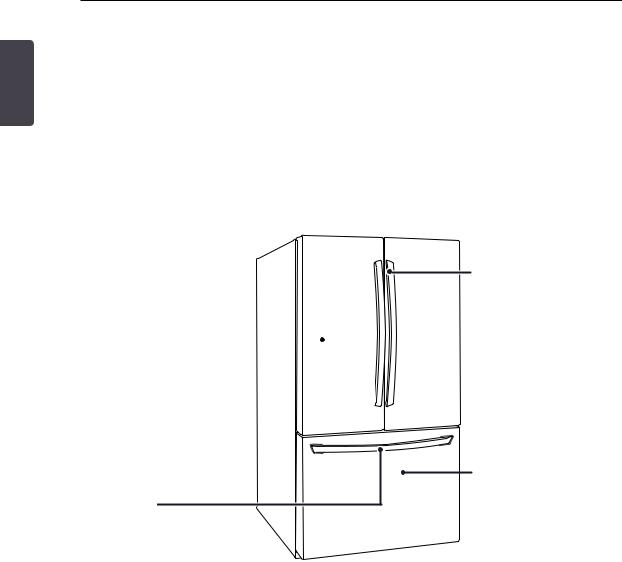
ENGLISH
7 COMPONENTS
COMPONENTS
Use this page to become more familiar with the parts and features of your refrigerator. Page references are included for your convenience.
*The appearance and speci cations of the actual product may di er depending on the model.
Refrigerator Exterior
Handle
O p e n s and clos e s the door.
Refrigerator 


Preserves food.
Freezer
Preserves frozen food.
Ez Handle
Easily open the freezer door.

COMPONENTS 8
Refrigerator Interior
ENGLISH
LED interior lamps
The interior lamps light up the inside of the refrigerator.
Fixed Door Bin
Used to preserve ch i l l e d f o o d o r drinks.
Crisper
Controls humidity and helps vegetables and fruit to stay crisp.
Ice Bin
Ice cubes are automatically produced.
Pullout Drawer
Used for extra storage within the freezer compartment.
Adjustable Refrigerator Shelf
The shelves in your refrigerator are adjustable to meet your individual storage needs.
Dairy Product Bin
Used to preser ve dairy products.
 Modular Door Bins
Modular Door Bins
Interchangeable bins can be arranged to su i t yo u r s t o rag e needs.
Auto Closing Hinge |
Durabase® and Durabase® Divider
T h e D u r a b a s e i s a s t o r a g e s p a c e recommended for the preservation of large food items. The Durabase Divider is used to organize the Durabase area into sections. It can be adjusted from side to side to accommodate items of di erent sizes.
The refrigerator doors and freezer drawers close automatically when you push them slightly.
(The door only closes automatically when it is open at an angle of less than 30°.)
Glide'N'Serve
Used for large party trays, deli items and beverages.
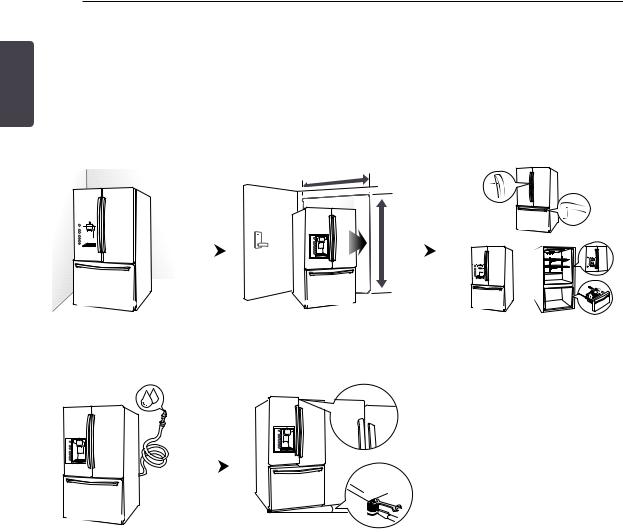
ENGLISH
9 INSTALLATION
INSTALLATION
Installation Overview
Please read the following installation instructions rst after purchasing this product or transporting it to another location.
|
|
|
|
|
|
|
|
|
|
|
|
|
|
|
|
|
|
|
|
|
|
|
|
|
|
|
|
|
|
|
|
|
|
|
|
|
|
|
|
|
|
|
|
|
|
|
|
|
|
|
|
|
|
|
|
|
|
|
|
|
|
|
|
|
|
|
|
|
|
|
|
|
|
|
|
|
|
|
|
|
|
|
|
|
|
|
|
|
|
|
|
|
|
|
|
|
|
|
|
|
|
|
|
|
|
|
|
|
|
|
|
|
|
|
|
|
|
|
|
|
|
|
|
|
|
|
|
|
|
|
|
|
|
|
|
|
|
|
|
|
|
|
|
|
|
|
|
|
|
|
|
|
|
|
|
|
|
|
|
|
|
|
|
|
|
|
|
|
|
|
|
|
|
|
|
|
|
|
|
|
|
|
|
|
|
|
|
|
|
|
|
|
|
|
|
|
|
|
|
|
|
|
|
|
|
|
|
|
|
|
|
|
|
|
|
|
|
|
|
|
|
|
|
|
|
|
|
|
|
|
|
|
|
|
|
|
|
|
|
|
|
|
|
|
|
|
|
|
|
|
|
|
|
|
|
|
|
|
|
|
|
|
|
|
|
|
|
|
|
|
|
|
|
|
|
|
|
|
|
|
|
|
|
|
|
|
|
|
|
|
|
|
|
|
|
|
|
|
|
|
|
|
|
|
|
|
|
|
|
|
|
|
|
|
|
|
|
|
|
|
|
|
|
|
|
|
|
|
|
|
|
|
|
|
|
|
|
|
|
|
|
|
|
|
|
|
|
|
|
|
|
|
|
|
|
|
|
|
|
|
|
|
|
|
|
|
|
|
|
|
|
|
|
|
|
|
|
|
|
|
|
|
|
|
|
|
|
|
|
|
|
|
|
|
|
|
|
|
|
|
|
|
|
|
|
|
|
|
|
|
|
|
|
|
|
|
|
|
|
|
|
|
|
|
|
|
|
|
|
|
|
|
|
|
|
|
|
|
|
|
|
|
|
|
|
|
|
|
|
|
|
|
|
|
|
|
|
|
|
|
|
|
|
|
|
|
|
|
|
|
|
|
|
|
|
|
|
|
|
|
|
|
|
|
|
|
|
|
|
|
|
|
|
|
|
|
|
|
|
|
|
|
|
|
|
|
|
|
|
|
|
|
|
|
|
|
|
|
|
|
|
|
|
|
|
|
|
|
|
|
|
|
|
|
|
|
|
|
|
|
|
|
|
|
|
|
|
|
|
|
|
|
|
|
|
|
|
|
|
|
|
|
|
|
|
|
|
|
|
|
|
1 Unpacking your |
|
|
|
|
|
2 Choosing the proper |
|
3 Disassembling/Assembling |
|||||||||||||||||||||||||||||||||||
|
refrigerator |
|
|
|
|
|
|
|
location |
|
|
|
|
|
|
|
|
|
|
|
|
|
|
|
|
|
|
|
|
|
|||||||||||||
|
|
|
|
|
|
|
|
|
|
|
|
|
|
|
|
|
|
|
|
|
|
|
|
|
|
|
|
|
|
|
|
|
|
|
|
|
|
|
|
|
|
|
|
|
|
|
|
|
|
|
|
|
|
|
|
|
|
|
|
|
|
|
|
|
|
|
|
|
|
|
|
|
|
|
|
|
|
|
|
|
|
|
|
|
|
|
|
|
|
|
|
|
|
|
|
|
|
|
|
|
|
|
|
|
|
|
|
|
|
|
|
|
|
|
|
|
|
|
|
|
|
|
|
|
|
|
|
|
|
|
|
|
|
|
|
|
|
|
|
|
|
|
|
|
|
|
|
|
|
|
|
|
|
|
|
|
|
|
|
|
|
|
|
|
|
|
|
|
|
|
|
|
|
|
|
|
|
|
|
|
|
|
|
|
|
|
|
|
|
|
|
|
|
|
|
|
|
|
|
|
|
|
|
|
|
|
|
|
|
|
|
|
|
|
|
|
|
|
|
|
|
|
|
|
|
|
|
|
|
|
|
|
|
|
|
|
|
|
|
|
|
|
|
|
|
|
|
|
|
|
|
|
|
|
|
|
|
|
|
|
|
|
|
|
|
|
|
|
|
|
|
|
|
|
|
|
|
|
|
|
|
|
|
|
|
|
|
|
|
|
|
|
|
|
|
|
|
|
|
|
|
|
|
|
|
|
|
|
|
|
|
|
|
|
|
|
|
|
|
|
|
|
|
|
|
|
|
|
|
|
|
|
|
|
|
|
|
|
|
|
|
|
|
|
|
|
|
|
|
|
|
|
|
|
|
|
|
|
|
|
|
|
|
|
|
|
|
|
|
|
|
|
|
|
|
|
|
|
|
|
|
|
|
|
|
|
|
|
|
|
|
|
|
|
|
|
|
|
|
|
|
|
|
|
|
|
|
|
|
|
|
|
|
|
|
|
|
|
|
|
|
|
|
|
|
|
|
|
|
|
|
|
|
|
|
|
|
|
|
4 Connecting the water |
5 Leveling and Door |
supply and water line |
Alignment |

INSTALLATION 10
Specifications
The appearance and speci cations listed in this manual may vary due to constant product improvements.
|
Width |
32 7/8" (W) X 35 1/2" (D) X 69 7/8" (H), 46" (D w/ door open) |
|
32 7/8 in. |
833 mm (W) X 901 mm (D) X 1775.5 mm (H), 1168.4 mm (D w/ |
Dimensions |
(833 mm) |
door open) |
|
|
|
|
Width |
29 3/4" (W) X 34 7/8" (D) X 68 1/2" (H), 44 3/4" (D w/ door open) |
|
29 3/4 in. |
755.65 mm (W) X 885.825 mm (D) X 1739.9 mm (H), |
|
(755.65 mm) |
1136.65 mm (D w/ door open) |
|
|
|
|
Width |
|
|
32 7/8 in. |
253 lb. (115 kg) |
Net weight |
(833 mm) |
|
Width |
|
|
|
|
|
|
29 3/4 in. |
237.4 lb. (107.9 kg) |
|
(755.65 mm) |
|
ENGLISH

ENGLISH
11 INSTALLATION
Unpacking Your Refrigerator
 WARNING
WARNING
Use two or more people to move and install the refrigerator. Failure to do so can result in back or other injury.
Your refrigerator is heavy. When moving the refrigerator for cleaning or service, be sure to protect the oor. Always pull the refrigerator straight out when moving it. Do not wiggle or walk the refrigerator when trying to move it, asoor damage could occur.
Keep ammable materials and vapors, such as gasoline, away from the refrigerator. Failure to do so can result in re, explosion, or death.
Remove tape and any temporary labels from your refrigerator before using. Do not remove any warning-type labels, the model and serial number label, or the Tech Sheet that is located under the front of the refrigerator.
To remove any remaining tape or glue, rub the area briskly with your thumb. Tape or glue residue can also be easily removed by rubbing a small amount of liquid dish soap over the adhesive with your ngers. Wipe with warm water and dry.
Do not use sharp instruments, rubbing alcohol,ammable uids, or abrasive cleaners to remove tape or glue. These products can damage the surface of your refrigerator.
Refrigerator shelves are installed in the shipping position. Please reinstall shelves according to your individual storage needs.
Choosing the Proper Location
Select a place where a water supply can be easily connected for the automatic icemaker.
 NOTE
NOTE
The water pressure must be between
20 and 120 psi (0,14 - 0,82 MPa) on models without a water lter and between 40 and 120 psi (0,28 - 0,82 MPa) on models with a water lter.
The refrigerator should al ways be plugged into its own individual properly grounded electrical outlet rated for 115/127 V~ 60 Hz, AC only, and fused at 15 or 20 A.
This provides the best performance and also prevents overloading house wiring circuits which could cause a re hazard from overheated wires. It is recommended that a separate circuit serving only this appliance be provided.
 WARNING
WARNING
To reduce the risk of electric shock, do not install the refrigerator in a wet or damp area.
Flooring
To avoid noise and vibration, the unit must be leveled and installed on a solidly constructedoor. If required, adjust the leveling legs to compensate for unevenness of the oor. The front should be slightly higher than the rear to aid in door closing. Leveling legs can be turned easily by tipping the cabinet slightly. Turn the leveling legs to the left to raise the unit or to the right to lower it. (See Leveling and Door AlIgnment.)
 NOTE
NOTE
Installing on carpeting, soft tile surfaces, a platform or weakly supported structure is not recommended.

INSTALLATION 12
Ambient Temperature
Install this appliance in an area where the temperature is between 55°F (13°C) and 110°F (43°C). If the temperature around the appliance is too low or high, cooling ability may be adversely a ected.
Measuring the Clearances
Too small of a distance from adjacent items may result in lowered freezing capability and increased electricity consumption charges. Allow at least 24 inches (61 cm) in front of the refrigerator to open the doors, and at least 2 inches (5.08 cm) between the back of the refrigerator and the wall.
24” (61 cm)
Removing/Assembling the
Refrigerator Door Handles
 NOTE
NOTE
When it is necessary to move the refrigerator through a narrow opening, removing the doors is the recommended procedure. If it is necessary to remove the handles, follow the directions below. The appearance of the handle may vary from what is shown in the illustrations
Removing the Handles
1 |
Loosen the set screws |
with a 3/32 in. |
|
|
Allen wrench and remove the handle. |
|
|
2 |
Loosen the mounting fasteners |
that |
|
connect to the refrigerator door and handle using a ¼ in. Allen wrench, remove the mounting fasteners.
2” (5.08 cm)
Assembling the Handles
1 Assemble the mounting fasteners  at
at
both ends of the handle using a ¼ in. Allen wrench.
2 Place the handle on the door by tting the handle footprints over the mounting fasteners and tightening the set screws  with a 3/32 in. Allen wrench.
with a 3/32 in. Allen wrench.
ENGLISH
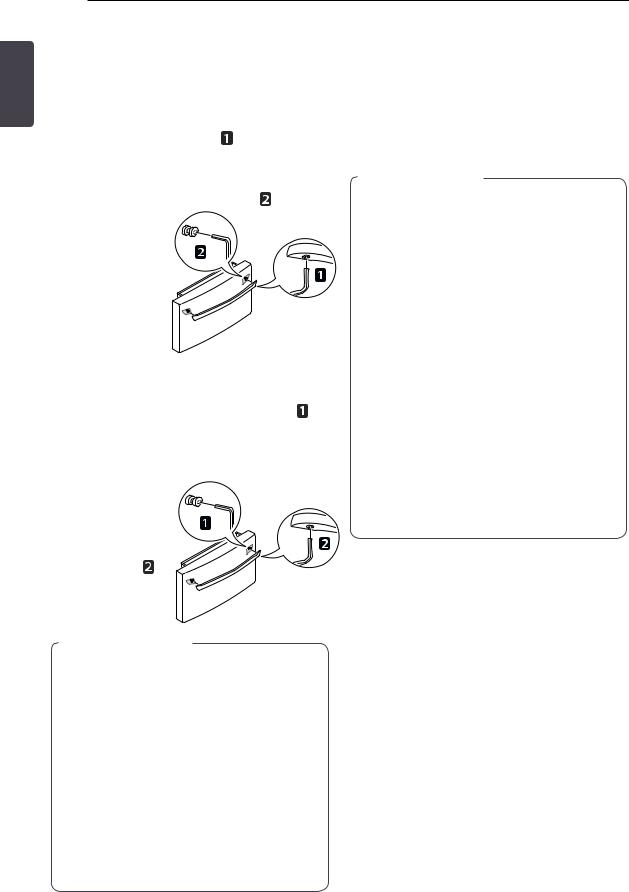
ENGLISH
13 INSTALLATION
Removing/Assembling the |
Removing/Assembling the |
Freezer Drawer Handle |
Doors and Drawers |
Removing the Handle
1 |
Loosen the set screws |
located on the |
|
|
lower side of the handle with a |
1/8 in. Allen |
|
|
wrench and remove the handle. |
|
|
2 |
Loosen the mounting fasteners |
that |
|
|
connect to the |
|
|
|
freezer drawer |
|
|
|
and handle |
|
|
|
using a 1/4 in. |
|
|
|
Allen wrench, |
|
|
|
and remove |
|
|
|
the mounting |
|
|
|
fasteners. |
|
|
Assembling the Handle
1 Assemble the mounting fasteners |
at |
both ends of the handle using a 1/4 in. Allen |
|
wrench. |
|
2 Place the handle on the door by tting the |
|
handle |
|
footprints over |
|
the mounting |
|
fasteners and |
|
tightening the |
|
set screws |
|
with a 1/8 in. |
|
Allen wrench. |
|
When it is necessary to move the refrigerator through a narrow opening, removing the doors is the recommended procedure.
 WARNING
WARNING
If your entrance door is too narrow for the refrigerator to pass through, remove the refrigerator doors and move the refrigerator sid eways through the doorway.
Use two or more people to remove and install the refrigerator doors. Failure to do so can result in back or other injury.
Disconnect the electrical supply to the refrigerator before installation. Failure to do so could result in serious injury or death.
Do not put hands, feet or other objects into the air vents or bottom of the refrigerator. You may be injured or receive an electrical shock.
Be careful when handling the hinge and stopper.You may be injured.
Remove food and bins before detaching the doors and drawers.
 WARNING
WARNING
When assembling or disassembling the handle:
Grasp the handle tightly to avoid dropping it.
Do not swing the handle into nearby people or animals.
Make sure that the bracket hole of the handle ts properly into the stopper bolt of the door. Assemble the set screws to x the handle into place.
Make sure that there is not a gap between the door and handle after assembling the handle.
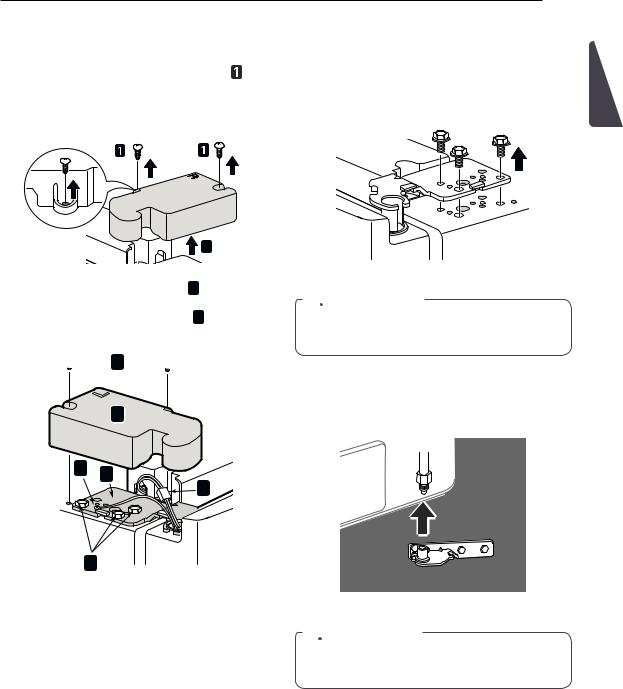
INSTALLATION 14
Removing the Left Refrigerator Door
1 R emove the top hinge cover screws |
. Lift |
the hook (not visible), located at the bottom of the front side of the cover  . with a athead screwdriver.
. with a athead screwdriver.
|
|
2 |
2 |
Disconnect the wire harness |
3 . |
3 |
R emove the grounding screw |
4 . |

 1
1 

2
4 |
6 |
|
|
|
3 |
|
5 |
4Remove the three bolts using a 10mm or
13/32-inch socket wrench and lift o the top hinge. Set parts aside.
 CAUTION
CAUTION
When lifting the hinge, be careful that the door does not fall forward.
5Lift the door from the middle hinge pin and remove the door.
 CAUTION
CAUTION
Place the door, inside facing up, on a non-scratching surface.
ENGLISH

ENGLISH
15 INSTALLATION
Removing the Right Refrigerator Door
1 R emove the top hinge cover screws |
. Lift |
3 Lift the door from the middle hinge pin and |
|
the hook (not visible), located at the bottom |
remove the door. |
||
of the front side of the cover |
. with a at- |
|
|
head screwdriver. |
|
|
|
 2
2
 CAUTION
CAUTION
Place the door, inside facing up, on a non-scratching surface.
2Remove the three bolts using a 10mm or
13/32-inch socket wrench and lift o the top hinge. Set parts aside.
 CAUTION
CAUTION
When lifting the hinge, be careful that the door does not fall forward.

INSTALLATION 16
Assembling the Right Refrigerator
Door
Install the right-side door rst.
1Make sure that the plastic sleeve is
inserted in the bottom of the door. Lower the door onto the middle hinge pin as shown in the gure.
4 Replace the hinge cover |
. Insert and |
tighten the cover screws |
. |
2 |
2 |
ENGLISH
2Align the door with the cabinet
3Line up the holes in the top hinge with the
holes in the top of the refrigerator. Insert and tighten the three bolts in the hinge.

17 INSTALLATION
|
Assembling the Left Refrigerator |
|
ENGLISH |
Door |
|
Install the left refrigerator door after the right |
||
|
||
|
door is installed. |
|
|
1 Make sure that the plastic sleeve is inserted |
|
|
in the bottom of the door. Install the |
|
|
refrigerator door onto the middle hinge. |
2Align the door with the cabinet
3Line up the holes in the top hinge with the
holes in the top of the refrigerator. Insert and tighten the three bolts in the hinge.
4 |
Replace the grounding screw |
3 . |
|
5 |
Reconnect the wire harness |
4 . |
|
6 |
Replace the hinge cover |
5 . Insert and |
|
|
tighten the cover screws |
6 . |
|

 6
6 

5
3

 4
4
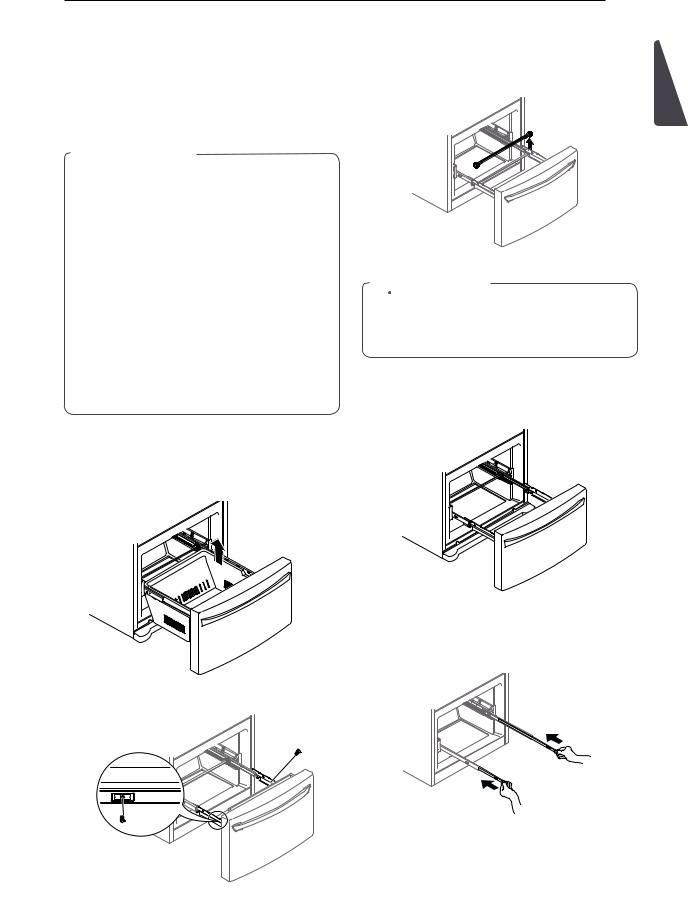
INSTALLATION 18
Removing the Freezer Drawers
The top, middle and bottom drawers are all removed in the same way. In the followinggures, the Pullout Drawer located above the freezer drawer is not shown for clarity.
 CAUTION
CAUTION
Use two or more people to remove and install the freezer drawer. Failure to do so can result in back or other injury.
Do not hold the handle when removing or replacing the drawer. The handle may come o , causing personal injury.
Be careful of sharp hinges on both sides of the drawer.
When you lay the drawer down, be careful not to damage the oor.
Do not sit or stand on the freezer drawer.
To prevent accidents, keep children and pets away from the drawer. Do not leave the drawer open.
1Pull the drawer open to full extension.
2Lift the DuraBase basket up and out, making sure to clear the rail system.
4 Slide out the bar.
 CAUTION
CAUTION
Do not hold the handle when removing or replacing the drawer. The handle may come o and it could cause personal injury.
5Grip both sides of the drawer and pull it up to remove it from the rails.
6 Holding one rail with each hand, push the rails in simultaneously.
3 Remove the screws at the ends of both rails
ENGLISH
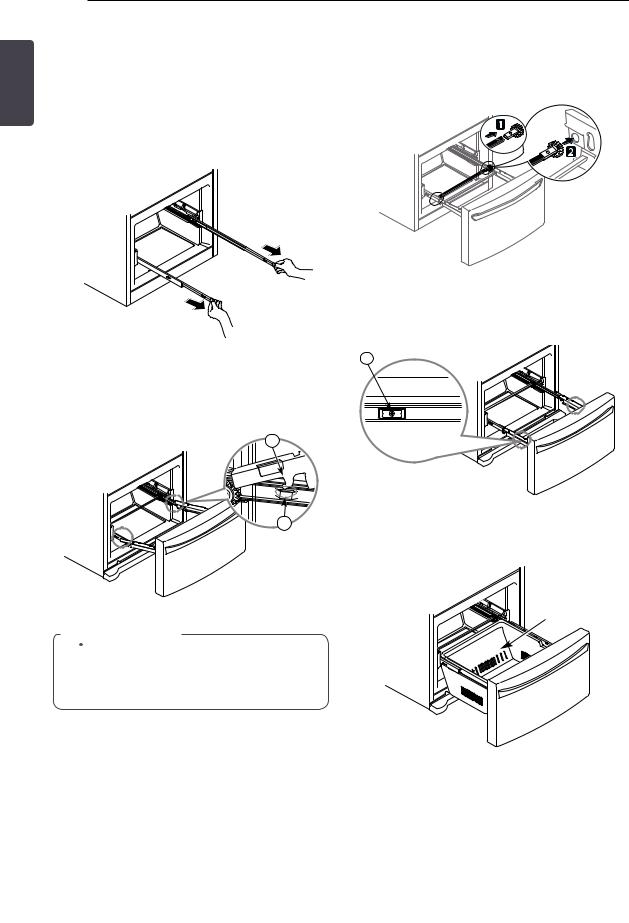
ENGLISH
19 INSTALLATION
Assembling the Freezer Drawers
The top, middle and bottom drawers are all |
3 Reinstall the bar in the drawer supports. |
assembled in the same way. |
|
1 Using two hands, pull out both rails |
|
simultaneously until they are fully extended. |
|
2Grasp the drawer on each side and hook the
drawer supports into the rail tabs located on both sides.
1
4Lower the door into its nal position and tighten the screws located on both sides.
3
2 |
5 W ith the drawer pulled out to full extension, |
|
insert the lower basket in the rail assembly. |
 CAUTION
CAUTION
Do not hold the handle when removing or replacing the drawer. The handle may come o and it could cause personal injury.
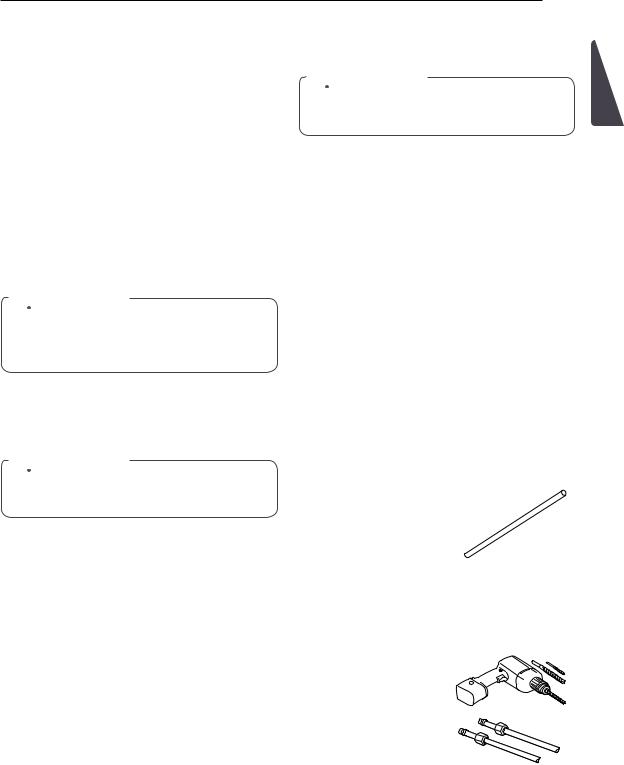
INSTALLATION 20
Connecting the Water Line
Before You Begin
This water line installation is not covered by the refrigerator warranty. Follow these instructions carefully to minimize the risk of expensive water damage.
Water hammer (water banging in the pipes) in house plumbing can cause damage to refrigerator parts and can lead to water leakage or ooding. Call a quali ed plumber to correct water hammer before installing the water supply line to the refrigerator.
 CAUTION
CAUTION
To prevent burns and product damage, only connect the refrigerator water line to a cold water supply.
If you use your refrigerator before connecting the water line, make sure the icemaker power switch is in the OFF (O) position.
 CAUTION
CAUTION
Do not install the icemaker tubing in areas where temperatures fall below freezing.
Water Pressure
You will need a cold water supply. The water pressure must be between 20 and 120 psi on models without a water lter and between 40 and 120 psi on models with a water lter.
If a reverse osmosis water ltration system is connected to your cold water supply, this water line installation is not covered by the refrigerator warranty. Follow the following instructions carefully to minimize the risk of expensive water damage.
If a reverse osmosis water ltration system is connected to your cold water supply, the water pressure to the reverse osmosis system needs to be a minimum of 40 to 60 psi (2.8 kgf/cm2 ~ 4.2 kgf/cm2, or less than 2.0~3.0 sec. to ll a cup of 7 oz capacity).
 CAUTION
CAUTION
Wear eye protection during installation to prevent injury.
If the water pressure from the reverse osmosis system is less than 21 psi or 1.5 kgf/cm2 (takes more than 4.0 sec to ll a cup of 7 oz capacity):
Check to see if the sediment lter in the reverse osmosis system is blocked. Replace the lter if necessary.
Allow the storage tank on the reverse osmosis system to re ll after heavy usage.
If the issue concerning water pressure from reverse osmosis remains, call a licensed, quali ed plumber.
All installations must be in accordance with local plumbing code requirements.
What You Will Need
|
Copper Tubing, ¼ in. outer diameter, |
|
t o c o n n e c t t h e r e f r i g e r a t o r t o |
|
t h e w a t e r s u p p l y. B e s u r e b o t h |
|
ends of the tubing are cut square. |
|
To determine h ow |
|
much tubing you need: |
|
measure the distance |
|
from the water valve |
|
on the back of the |
|
refrigerator to the |
|
water supply pipe. Then, add 8 feet (2.4 |
|
m). Be sure there is su cient extra tubing |
|
(about 8 feet [2.4 m] coiled into 3 turns of |
|
about 10 in. [25 cm] diameter) to allow the |
|
refrigerator to move out from the wall after |
|
installation. |
|
Power drill. |
|
½ in. or adjustable |
|
wrench. |
|
Flat blade and Phillips |
|
head screwdrivers. |
|
Two ¼ in. outer |
|
diameter compression |
|
nuts and 2 ferrules |
|
(sleeves) to connect the copper tubing to |
|
the shuto valve and the refrigerator water |
|
valve. |
ENGLISH
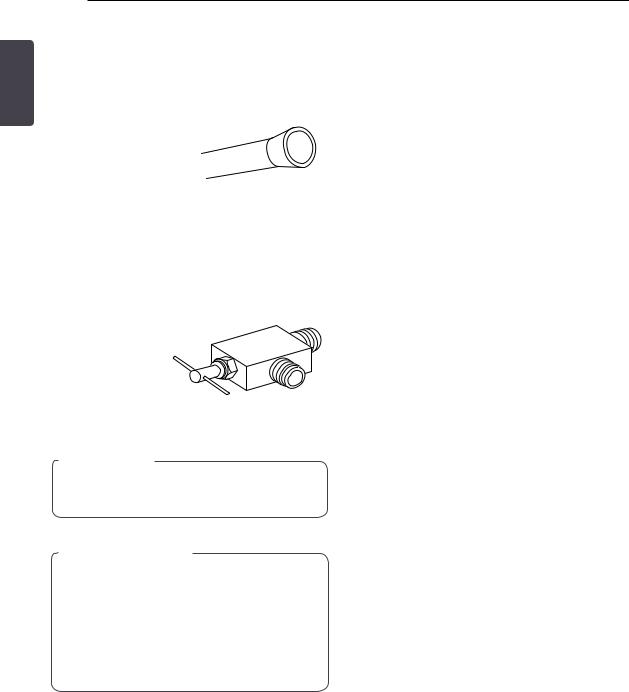
ENGLISH
21 INSTALLATION
If your existing copper water line has a ared tting at the end, you will need an adapter (available at
plumbing supply stores) to connect the water line
to the refrigerator OR you can cut o the ared tting
with a tube cutter and then use a compression tting.
Shutoff valve to connect to the cold water line.The shuto valve should have a water inlet with a minimum inside diameter of 5/32 in. at the point of connection to the COLD WATER LINE. Saddle-type shuto valves are included in many water supply kits.
Before purchasing, make sure a saddletype valve
complies with your local plumbing codes.
 NOTE
NOTE
A self-piercing saddle type water valve should not be used.
 WARNING
WARNING
Electrical Shock Hazard:
When using any electrical device (such as a power drill) during installation, be sure the device is battery powered, double insulated or grounded in a manner that will prevent the hazard of electric shock.
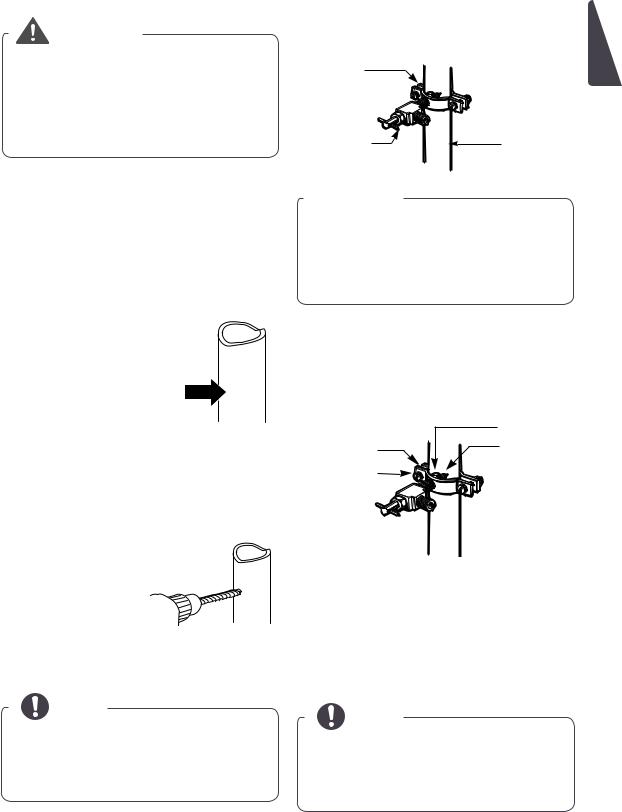
|
|
INSTALLATION 22 |
|
|
|
|
|
Water Line Installation Instructions |
4 FASTENTHE SHUTOFF VALVE |
||
|
WARNING |
Fasten the shuto valve to the cold water |
|
|
pipe with the pipe clamp. |
||
When using any electrical device (such as a power drill) during installation, be sure the device is battery powered, double insulated or grounded in a manner that will prevent the hazard of electric shock.
Inst all the shuto valve on the nearest frequently used drinking water line.
Pipe Clamp
Saddle-Type |
Vertical Cold |
Shuto Valve |
Water Pipe |
 NOTE
NOTE
1SHUT OFF THE MAIN WATER SUPPLY
Turn on the nearest faucet to relieve the pressure on the line.
2 C H O O S E T H E V A LV E L O C A T I O N
Commonwealth of Massachusetts Plumbing Codes 248CMR shall be adhered to. Saddle valves are illegal and use is not permitted in Massachusetts. Consult with your licensed plumber.
C h o o s e a l o c a t i o n for the valve that is easily accessible. It is best to connect into the side of a vertical water pipe. When it is necessary to connect
into a horizontal water pipe, make the connection to the top or side, rather than at the bottom, to avoid drawing o any sediment from the water pipe.
3 D R I L L T H E H O L E F O R T H E VA LV E
Drill a ¼ in. hole in
the water pipe using a sharp bit. Remove
any burrs resulting
f r o m d r i l l i n g t h e h o l e i n t h e p i p e .
Be careful not to
allow water to drain into the drill. Failure to drill a ¼ in. hole may result in reduced ice production or smaller cubes.
5TIGHTENTHE PIPE CLAMP
Tighten the clamp screws until the sealing washer begins to swell.
NOTE: Do not overtighten clamp or you may crush the tubing.
Washer
Pipe Clamp |
Inlet End |
Clamp Screw
6ROUTETHETUBING
Route the tubing between the cold water line and the refrigerator.
Route the tubing through a hole drilled in the wall or oor (behind the refrigerator or adjacent base cabinet) as close to the wall as possible.
NOTE |
NOTE |
|
The hookup line cannot be white, plastic |
||
Be sure there is su cient extra tubing (about |
||
tubing. Licensed plumbers must use only |
||
8 feet coiled into 3 turns of about 10 in. |
||
copper tubing (NDA tubing #49595 or #49599) |
||
diameter) to allow the refrigerator to move |
||
or Cross Link Polyethylene (PEX) tubing. |
||
out from the wall after installation.. |
||
|
ENGLISH
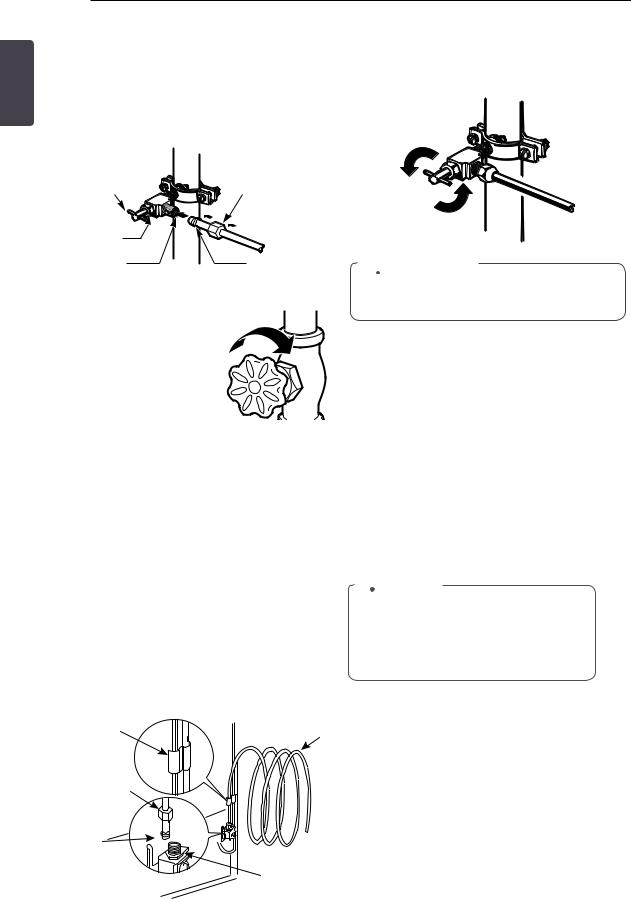
ENGLISH
23 INSTALLATION
7CONNECTTHETUBINGTOTHE VALVE
Place the compression nut and ferrule (sleeve) for copper tubing onto the end of the tubing and connect it to the shuto valve. Make sure the tubing is fully inserted into the valve.Tighten the compression nut securely.
Saddle-Type |
Compression |
Shuto Valve |
Nut |
Packing Nut |
|
Outlet Valve |
Ferrule (sleeve) |
8 FLUSH OUT THE TUBING
Turn the main water supply on and ush out the tubing until the water is clear.
Shut the water o at the water valve after
a b o u t o n e q u a r t o f
water has been ushed through the tubing.
9CONNECTTHETUBINGTOTHE REFRIGERATOR
NOTE: Before making the connection to the refrigerator, be sure that the refrigerator power cord is not plugged into the wall outlet.
10TURNTHE WATER ON ATTHE SHUTOFF VALVE
Tighten any connections that leak.
 CAUTION
CAUTION
Check to see if leaks occur at the water line connections.
11PLUG INTHE REFRIGERATOR
Arrange the coil of tubing so that it does not vibrate against the back of the refrigerator or against the wall. Push the refrigerator back to the wall.
12STARTTHE ICEMAKER
Set the icemaker power switch to the |
ON |
position. |
|
The icemaker will not begin to operate until it reaches its operating temperature of 15°F (–9°C) or below. It will then begin operation automatically if the icemaker power switch is in the ON (I) position.
a. Remove the plastic exible cap from the water valve.
b. Place the compression nut and ferrule (sleeve) onto the end of the tubing as shown.
c. Insert the end of the copper tubing into the connection as far as possible. While holding the tubing, tighten the tting.
Tubing Clamp
¼ in.Tubing
¼ in. Compression
Nut
Ferrule (sleeve)
R e f r i g e r a t o r
Connection
 NOTE
NOTE
Never use old or used hoses. Always use new ones to have a better use and experience. Connect always to a potable water source to avoid security and health issues.
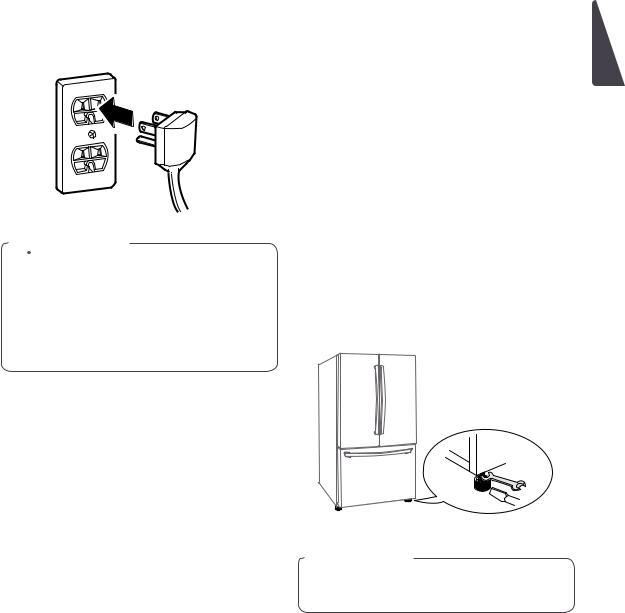
|
|
INSTALLATION 24 |
|
|
|
|
|
Turning On The Power |
Leveling and Door Alignment |
||
1 Plug in the refrigerator. |
Leveling |
||
 CAUTION
CAUTION
Connect to a rated power outlet.
Have a certi ed electrician check the wall outlet and wiring for proper grounding.
Do not damage or cut o the ground terminal of the power plug.
After installing, plug the refrigerator’s power cord into a 3-prong grounded outlet and push the refrigerator into the nal position.
Your refrigerator has two front leveling legs— one on the right and one on the left. Adjust the legs to alter the tilt from front-to-back or side-to- side. If your refrigerator seems unsteady, or you want the doors to close more easily, adjust the refrigerator’s tilt using the instructions below:
1Turn the leveling leg to the left to raise
that side of the refrigerator or to the right to lower it. It may take several turns of the leveling leg to adjust the tilt of the refrigerator.
ENGLISH
 NOTE
NOTE
A are nut wrench works best, but an openend wrench will su ce. Do not over-tighten.
2Open both doors again and check to make
sure that they close easily. If the doors do not close easily, tilt the refrigerator slightly more to the rear by turning both leveling legs to the left. It may take several more turns, and you should turn both leveling legs the same amount.
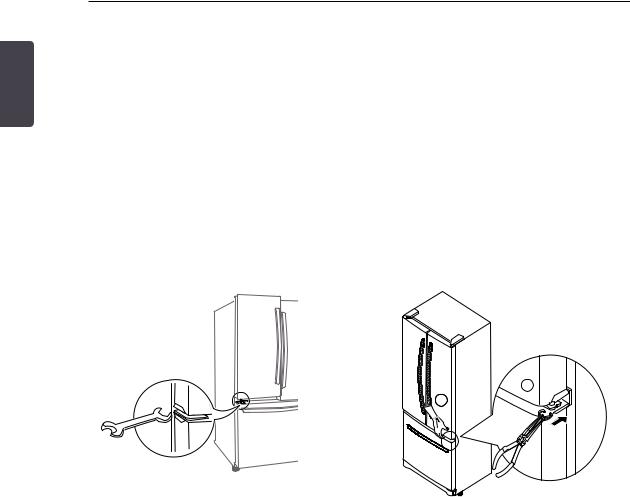
25 INSTALLATION
ENGLISH
Door Alignment (Type 1)
Both the left and right refrigerator doors have an adjustable nut, located on the bottom hinge, to raise and lower them to align properly. If the space between your doors is uneven, follow the instructions below to align the doors evenly:
Use the wrench (included with the Owner’s Manual) to turn the nut in the door hinge to adjust the height. To the right to raise or to the left to lower the height.
Door Alignment (Type 2)
If the spacing between the doors is uneven, follow the instructions below to align them:
1.With one hand, lift up the door you want to raise at middle hinge.
2.With other hand, use pliers to insert snap ring as shown.
3.Insert additional snap rings until the doors are aligned (Three snap rings are provided per unit).
2
1

HOW TO USE 26
HOW TO USE
Before use
Clean the refrigerator.
Clean your refrigerator thoroughly and wipe o all dust that accumulated during
shipping.
 CAUTION
CAUTION
Do not scratch the refrigerator with a sharp object or use a detergent that contains alcohol, a ammable liquid or an abrasive when removing any tape or adhesive from the refrigerator,.
Do not peel o the model or serial number label or the technical information on the rear surface of the refrigerator.
 NOTE
NOTE
Remove adhesive residue by wiping it o with your thumb or dish detergent.
Connect the power supply.
Check if the power supply is connected before use.
Read the “Turning OnThe Power” section.
Turn off the icemaker if the refrigerator is not yet connected to the water supply.
Turn o the automatic icemaker and then plug the power plug of the refrigerator into the grounded electric outlet.
*This is applicable only to certain models.
 CAUTION
CAUTION
Running the automatic icemaker before connecting it to the water supply may cause the refrigerator to malfunction.
Wait for the refrigerator to cool.
Allow your refrigerator to run for at least two to three hours before putting food in it. Check the ow of cold air in the freezer compartment to ensure proper cooling.
 CAUTION
CAUTION
Putting food in the refrigerator before it has cooled could cause the food to spoil, or a bad odor could remain inside the refrigerator.
The refrigerator makes a loud noise after initial operation.
This is normal.The volume will decrease as the temperature lowers.
Open refrigerator doors and freezer drawers to ventilate the interior.
ENGLISH
The inside of the refrigerator may smell like plastic at rst. Remove any adhesive tape from inside the refrigerator and open the refrigerator doors and the freezer drawers for ventilation.
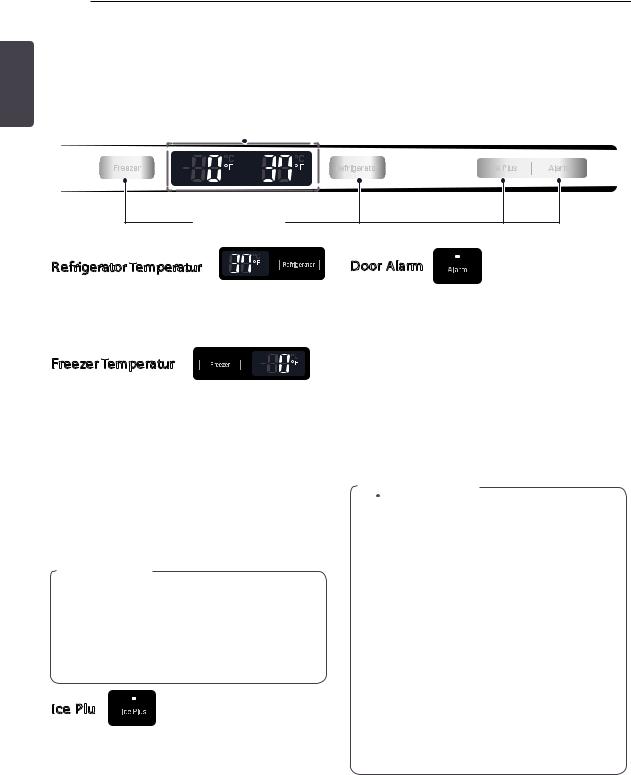
ENGLISH
27 HOW TO USE
Control Pad
* Depending on the model, some of the following functions may not be available.
Control Pad Features
 LED Display Indicator
LED Display Indicator
Control Button
RefrigeratorTemperature 
Indicates the set temperature of the refrigerator compartment in Celsius (°C) or Fahrenheit (°F).
FreezerTemperature
Indicates the set temperature of the freezer compartment in Celsius (°C) or Fahrenheit (°F).
To change the temperature mode from °F to °C (or vice versa) press and hold the Refrigerator and Freezer temperature buttons simultaneously for approximately ve seconds.The temperature indicator on the display window switches between Celsius and Fahrenheit.
 NOTE
NOTE
The displayed temperature is the target temperature, and not the actual temperature of the refrigerator. The actual refrigerator temperature depends on the food inside the refrigerator.
Ice Plus
This function increases both ice making and freezing capabilities.
When you touch the Ice Plus button, the graphic will illuminate in the display and will continue for 24 hours. The function will automatically shut o after 24 hours.
You can stop this function manually by touching the button one more time.
Door Alarm
When p ower is connected to th e refrigerator, the door alarm is initially set
to ON. When you press the Door Alarm button, the display will change to OFF and the Door Alarm function will deactivate.
When either the refrigerator or the freezer door is left open for more than 60 seconds, the alarm tone will sound to let you know that the door is open.
When you close the door, the door alarm will stop.
 CAUTION
CAUTION
Display Mode (For Store Use Only)
The Display Mode disables all cooling in the refrigerator and freezer sections to conserve energy while on display in a retail store. When activated OFF will display
on the control panel and the display will remain on for 20 seconds.
To deactivate / activate:
With either refrigerator door opened, press and hold the Refrigerator and Ice Plus buttons at the same time for ve seconds. The control panel will beep and the temperature settings will display to con rm that Display Mode is deactivated. Use the same procedure to activate Display Mode.

HOW TO USE 28
Automatic Icemaker
(Freezer Room)
*Depending on the model, some of the following functions may not be available.
Ice is made in the automatic icemaker and sent to the dispenser. The icemaker will produce 12 cubes per cycle—approximately 120 cubes in a 24-hour period, depending on freezer compartment temperature, room temperature, number of door openings and other operating conditions.
Automatic |
Power Switch |
Shut O Arm |
|
Turning the Automatic Icemaker On or Off
It takes about 12 to 24 hours for a newly installed refrigerator to begin making ice.
The water pressure must be between 20 and 120 psi on models without a water lter and between 40 and 120 psi on models with a water lter to produce the normal amount and size of ice cubes.
Foreign substances or frost on the ice-detecting sensor can interrupt ice production. Make sure the sensor area is clean at all times for proper operation.
To turn o the automatic icemaker, set the icemaker switch to OFF (O) . To turn on the automatic icemaker, set the switch to ON (I) .
ENGLISH

ENGLISH
29 HOW TO USE
Automatic Icemaker (continued)
 CAUTION
CAUTION
The rst ice produced may include particles or odor from the water supply line or the water tank.
Throw away the rst few batches of ice (about 24 cubes). This is also necessary if the refrigerator has not been used for a long time.
Never store beverage cans or other items in the ice bin for the purpose of rapid cooling. Doing so may damage the icemaker or the containers may burst.
If discolored ice is dispensed, check the water lter and water supply. If the problem continues, contact a quali ed service center. Do not use the ice or water until the problem is corrected.
Be sure nothing interferes with the sweep of the automatic shut o arm.
It is normal for some cubes to be stuck together.
If ice is not used frequently, old ice cubes will become cloudy, taste stale, and shrink.
Never use thin crystal glass or crockery to collect ice. Such containers may chip or break resulting in glass fragments in the ice.
When You Should Turn the
Icemaker Off
When the water supply will be shut o for several hours.
When the ice bin is removed for more than one or two minutes.
When the refrigerator will not be used for several days.
 NOTE
NOTE
The ice bin should be emptied when the icemaker on/o switch is turned to the OFF position.
Normal Sounds You May Hear
The icemaker water valve will buzz as the icemaker lls with water. If the power switch is in the ON (I) position, it will buzz even if it has not yet been hooked up to water. To stop the buzzing, move the power switch to OFF (O).
 NOTE
NOTE
Keeping the power switch in the ON (I) position before the water line is connected can damage the icemaker.
You will hear the sound of cubes dropping into the bin and water running in the pipes as the icemaker re lls.
Preparing For Vacation
Set the icemaker power switch to OFF (O) and shut o the water supply to the refrigerator.
 NOTE
NOTE
The ice bin should be emptied anytime the icemaker on/o switch is turned to the OFF
(O) position.
If the ambient temperature will drop below freezing, have a quali ed technician drain the water supply system to prevent serious property damage due to ooding caused by ruptured water lines or connections.
